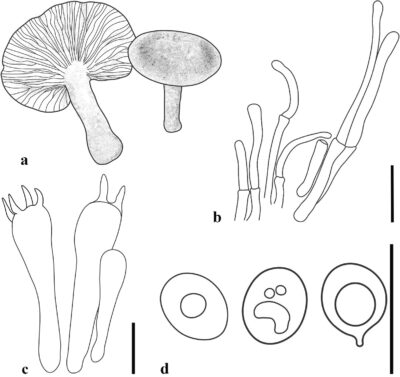Fungalpedia – Note 402, Clitocella
Clitocella Kluting, T.J. Baroni & Bergemann
Citation when using this data: Tibpromma et al. 2024 (in prep.) – Fungalpedia, Macrofungi.
Index Fungorum, Facesoffungi, MycoBank, GenBank, Fig. 1
Classification: Entolomataceae, Agaricales, Agaricomycetidae, Agaricomycetes, Agaricomycotina, Basidiomycota, Fungi.
Clitocella was introduced by Kluting et al. (2014) within the Entolomataceae of the Agaricomycetes, designating Clitocella popinalis as the type species. Utilizing maximum likelihood analysis of atp6, rpb2, and tef1 sequences, Kluting et al. (2014) demonstrated that Clitocella is phylogenetically sister to Clitopilus. This relationship forms a highly supported clade with Clitopilus, which is a sister to Clitopilopsis, as supported by various studies (Co-David et al. 2009, Kluting et al. 2014, Morgado et al. 2016, Vizzini et al. 2016, Sánchez-García and Matheny 2017, Boccardo & Dovana 2019, Baroni et al. 2020, Sánchez-García et al. 2020, Mao et al. 2022). Clitopilus species, which share a clitocyboid habit with Clitocella, are distinguished by their basidiospores, which are ornamented with pustules arranged in longitudinal ridges according to Noordeloos (1988, 2012). Clitopilopsis is differentiated by features such as subdistant lamellae, nearly smooth basidiospores with thickened walls, and multiseptate hymenial cystidia, as noted by Kluting et al. (2014) and Jian et al. (2020). Clitocella is characterized by pilei that are usually pale grey, dark grey, or violaceous black, with basidiome surfaces that remain unchanged or turn grey or black when bruised or aged. Clitopilus typically shows a positive, reddish KOH reaction, an irregular hymenophoral trama, and basidiospores that range from globose to ellipsoid, which are obscurely to clearly angular and weakly to clearly pustulate, as described by Vizzini et al. (2023). Clitocella is a saprotrophic genus with a wide distribution, found in forested or grassy areas and on dunes across America (north, south, and central), Asia, Europe. Notably, Clitocella species are usually terrestrial, although Clitocella termitophila has been observed to grow on arboreal nests of neotropical termites (Baroni et al. 2020). According to Index Fungorum (2024), there are currently twenty-three species epithets within Clitocella.
Type species: Clitocella popinalis (Fr.) Kluting, T.J. Baroni & Bergemann
Other accepted species: Species Fungorum – search Clitocella
Figure 1 – Clitocella popinalis. a Basidiomes (AMB 18369, neotype). b Pileipellis (AMB 18369, neotype). c Basidia and basidiospores (CL 91101234). d Basidiospores (O-F 252975). Scale bars: b = 30 μm, c, d = 10 μm. Redrawn from Vizzini et al. (2023).
References
Boccardo F, Dovana F. 2019 – Prima segnalazione di Rhodocybe tugrulii in Italia. Annales Confederationis Europaeae Mycologiae Mediterraneensis 2016, 86–93.
Contu M. 2002 – Il genere Rhodocybe (Basidiomycetes, Entolomataceae) in Italia. I. Sezione Decurrentes. Micologia e Vegetazione Mediterranea 17, 95–114.
Noordeloos ME. 2012 – Clitopilus (Fr.: Fr.) P. Kumm. In: Knudsen H, Vesterholt J (eds), Funga Nordica, 2nd edition. Vol. 2. Agaricoid, boletoid, clavarioid, cyphelloid and gastroid genera: 515–517. Nordsvamp, Copenhagen, Denmark.
Entry by
Wanasinghe DN, Center for Mountain Futures, Kunming Institute of Botany, Chinese Academy of Sciences, Honghe 654400, China.
(Edited by Saowaluck Tibpromma, Samaneh Chaharmiri-Dokhaharani, & Achala R. Rathnayaka)
Published online 26 November 2024
